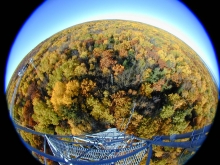You are here
New Study: Changing Atmosphere Boosts Water Efficiency in Trees

A study published today in the journal Nature, led by Harvard faculty member Andrew Richardson and post-doctoral fellow Trevor Keenan, uses more than 20 years of data from Harvard Forest research towers to explain how rising CO2 levels help trees use water more efficiently.
As trees become more efficient at using water, the researchers explain, they gain increased capacity for growth and, thus, the ability to remove more carbon dioxide from the atmosphere. Although computer models in the past predicted this so-called "carbon dioxide fertilization effect," the study clarifies that the actual effect is far stronger than expected.
Although the short-term outcome looks positive for trees, the researchers point out that the overall impacts of climate change--rising global temperatures and changes in rainfall patterns--remain a great concern for plant growth in many parts of the world.
The project was supported by grants from NOAA's Atmospheric Chemistry, Carbon Cycle, and Climate Program; the National Science Foundation's Long-Term Ecological Research Program; the Department of Energy's Biological and Environmental Research Program; and the U.S. Forest Service's Northern Research Station.
- Read the New York Times coverage.
- Read the National Science Foundation press release.
- Read the Harvard Gazette story.
- Browse the original scientific paper.
(photo credit: Chris Vogel)

